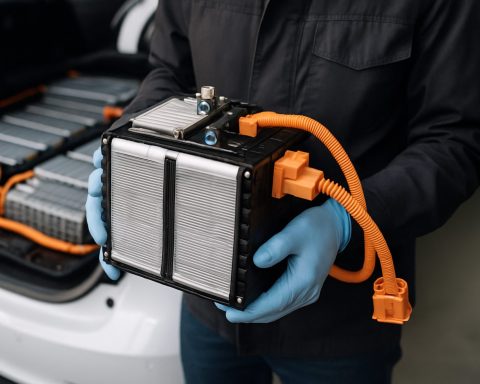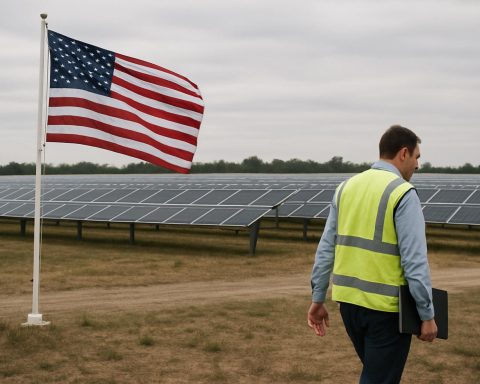Vehicle-to-Grid Charging Infrastructure Market Report 2025: In-Depth Analysis of Growth Drivers, Technology Innovations, and Regional Opportunities. Explore Key Trends, Forecasts, and Competitive Insights Shaping the V2G Landscape.
- Executive Summary and Market Overview
- Key Technology Trends in Vehicle-to-Grid Charging
- Competitive Landscape and Leading Players
- Market Growth Forecasts and CAGR Analysis (2025–2030)
- Regional Market Analysis and Emerging Hotspots
- Challenges, Risks, and Market Opportunities
- Future Outlook: Strategic Recommendations and Investment Insights
- Sources & References
Executive Summary and Market Overview
Vehicle-to-Grid (V2G) charging infrastructure refers to the systems and technologies that enable bidirectional energy flow between electric vehicles (EVs) and the power grid. This infrastructure allows EVs not only to draw electricity for charging but also to return stored energy to the grid, supporting grid stability, demand response, and renewable energy integration. As of 2025, the V2G market is transitioning from pilot projects to early-stage commercial deployments, driven by the rapid adoption of EVs, grid modernization efforts, and supportive regulatory frameworks.
The global V2G charging infrastructure market is projected to experience robust growth, with estimates suggesting a compound annual growth rate (CAGR) exceeding 30% through the end of the decade. Key drivers include the proliferation of EVs, particularly in regions such as Europe, North America, and parts of Asia-Pacific, where governments are incentivizing both EV adoption and smart grid investments. According to International Energy Agency, the global EV stock surpassed 40 million units in 2024, creating a substantial base for V2G integration.
Major automakers and energy companies are forming strategic partnerships to accelerate V2G infrastructure deployment. For example, Nissan and Enel have expanded their V2G pilot programs in Europe, while Ford and DTE Energy are collaborating on V2G-ready vehicles and charging stations in the United States. These initiatives are supported by evolving standards, such as ISO 15118, which facilitate secure and interoperable communication between vehicles and the grid.
Despite the positive outlook, the market faces challenges including high initial infrastructure costs, regulatory uncertainty, and the need for widespread standardization. However, government funding and policy support are mitigating some of these barriers. The European Union’s Alternative Fuels Infrastructure Regulation (AFIR) and the United States’ Infrastructure Investment and Jobs Act are channeling significant resources into smart charging and V2G projects (European Commission, U.S. Department of Transportation).
In summary, the V2G charging infrastructure market in 2025 is characterized by accelerating investment, expanding pilot-to-commercial transitions, and a growing ecosystem of stakeholders. The sector is poised for significant expansion as technology matures and policy frameworks evolve to support grid-interactive EVs.
Key Technology Trends in Vehicle-to-Grid Charging
Vehicle-to-Grid (V2G) charging infrastructure is rapidly evolving in 2025, driven by the increasing adoption of electric vehicles (EVs) and the growing need for grid flexibility. V2G technology enables bidirectional energy flow between EVs and the power grid, allowing vehicles to not only draw power for charging but also return stored energy to the grid during peak demand periods. This infrastructure comprises advanced charging stations, communication protocols, and grid integration systems that collectively support seamless energy exchange.
One of the most significant trends in 2025 is the deployment of high-capacity, bidirectional charging stations. These stations are being installed at both public and private locations, including commercial fleets, residential complexes, and utility-owned sites. Major charging network operators and automakers are collaborating to standardize hardware and software interfaces, ensuring interoperability across different vehicle models and charging networks. For example, the adoption of the ISO 15118 protocol is becoming widespread, enabling secure, automated communication between EVs and charging infrastructure for V2G services International Organization for Standardization.
- Integration with Smart Grids: Utilities are investing in V2G-ready infrastructure that can dynamically respond to grid conditions. Advanced energy management systems are being deployed to aggregate and control distributed EV resources, optimizing when and how vehicles charge or discharge based on real-time grid needs National Renewable Energy Laboratory.
- Commercial Fleet Adoption: Fleet operators are emerging as early adopters of V2G infrastructure, leveraging large numbers of parked vehicles as grid assets. Partnerships between fleet owners, utilities, and technology providers are accelerating the rollout of depot-based V2G charging hubs FleetCarma.
- Residential V2G Solutions: Automakers and energy companies are piloting home-based V2G chargers, allowing individual consumers to participate in grid services and benefit from dynamic electricity pricing EDF Energy.
Looking ahead, the expansion of V2G charging infrastructure is expected to be supported by regulatory incentives, utility programs, and continued advancements in battery and communication technologies. As the market matures, interoperability, cybersecurity, and user experience will remain key focus areas for stakeholders across the V2G ecosystem.
Competitive Landscape and Leading Players
The competitive landscape of the vehicle-to-grid (V2G) charging infrastructure market in 2025 is characterized by a dynamic mix of established energy companies, automotive manufacturers, technology startups, and utility providers. The sector is witnessing rapid innovation, strategic partnerships, and pilot deployments as stakeholders vie for early leadership in this emerging field.
Key players in the V2G charging infrastructure market include major automotive manufacturers such as Nissan Motor Corporation, which has been a pioneer with its LEAF-to-Grid initiatives, and Ford Motor Company, which is integrating V2G capabilities into its electric vehicle lineup. These automakers are collaborating with energy companies and technology providers to develop interoperable V2G solutions.
On the charging hardware and software front, companies like Enel X and Fermata Energy are leading the deployment of bidirectional charging stations and V2G management platforms. Enel X has launched several large-scale V2G pilot projects in Europe and North America, while Fermata Energy is known for its partnerships with utilities and fleet operators in the United States.
Utility companies are also playing a pivotal role. EDF Energy and E.ON SE have invested in V2G demonstration projects, aiming to integrate EVs as distributed energy resources within their grids. These utilities are exploring business models that incentivize EV owners to participate in grid services, such as frequency regulation and demand response.
The competitive environment is further shaped by technology startups and software providers, including Nuvve Holding Corp., which specializes in V2G aggregation platforms. Nuvve has secured contracts with school districts and commercial fleets, enabling them to monetize their EV assets through grid services.
- Nissan Motor Corporation: Early V2G adopter with global pilot programs.
- Ford Motor Company: Integrating V2G in new EV models.
- Enel X: Leading V2G infrastructure provider in Europe and North America.
- Fermata Energy: US-based V2G technology and software innovator.
- EDF Energy and E.ON SE: Utilities investing in V2G grid integration.
- Nuvve Holding Corp.: V2G aggregation and fleet solutions.
The market is expected to see increased consolidation and collaboration in 2025, as regulatory frameworks mature and the commercial viability of V2G services becomes clearer. Strategic alliances between automakers, utilities, and technology providers will be crucial in scaling V2G infrastructure and unlocking new revenue streams.
Market Growth Forecasts and CAGR Analysis (2025–2030)
The global vehicle-to-grid (V2G) charging infrastructure market is poised for robust growth between 2025 and 2030, driven by accelerating electric vehicle (EV) adoption, supportive regulatory frameworks, and increasing investments in smart grid technologies. According to projections by MarketsandMarkets, the V2G market is expected to register a compound annual growth rate (CAGR) of approximately 35% during this period, with the market value anticipated to surpass USD 5 billion by 2030.
Key growth drivers include the rapid expansion of EV fleets, particularly in North America, Europe, and parts of Asia-Pacific, where governments are incentivizing both EV adoption and grid modernization. The European Union’s Green Deal and the United States’ Infrastructure Investment and Jobs Act are catalyzing investments in V2G pilot projects and large-scale deployments, further accelerating market expansion. International Energy Agency (IEA) data indicates that by 2025, the global EV stock could exceed 50 million units, providing a substantial foundation for V2G integration.
From 2025 onward, the market is expected to transition from pilot programs to commercial-scale rollouts, particularly as utilities and grid operators recognize the value of V2G in balancing supply and demand, integrating renewables, and enhancing grid resilience. BloombergNEF forecasts that by 2030, V2G-enabled EVs could provide up to 100 GW of flexible capacity globally, underscoring the technology’s potential impact on energy markets.
- Regional Outlook: Europe is projected to lead the market, with a CAGR exceeding 38%, driven by aggressive decarbonization targets and advanced grid infrastructure. North America and Asia-Pacific are also expected to witness significant growth, supported by policy incentives and expanding EV charging networks.
- Segment Analysis: The residential V2G segment is anticipated to grow rapidly as home charging solutions become more sophisticated, while commercial and fleet applications will account for a substantial share of new installations, particularly in urban centers and logistics hubs.
In summary, the 2025–2030 period will be characterized by exponential growth in V2G charging infrastructure, underpinned by technological advancements, regulatory support, and the increasing convergence of the automotive and energy sectors.
Regional Market Analysis and Emerging Hotspots
The global vehicle-to-grid (V2G) charging infrastructure market is experiencing significant regional disparities in adoption, driven by policy frameworks, electric vehicle (EV) penetration, grid modernization efforts, and utility engagement. In 2025, Europe and North America are leading the deployment of V2G infrastructure, while Asia-Pacific is rapidly emerging as a key growth hotspot.
Europe remains at the forefront, propelled by ambitious decarbonization targets and supportive regulatory environments. Countries such as the Netherlands, the UK, and Germany have launched large-scale V2G pilot projects, integrating thousands of bidirectional chargers into urban and suburban grids. The European Union’s “Fit for 55” package and the Alternative Fuels Infrastructure Regulation (AFIR) are catalyzing investments in V2G-ready charging stations, with utilities and automakers like Enel X and Nissan actively participating in grid-balancing initiatives. By 2025, Europe is expected to account for over 40% of global V2G infrastructure deployments, according to IDTechEx.
North America is witnessing accelerated V2G infrastructure growth, particularly in the United States and Canada. Federal incentives under the Infrastructure Investment and Jobs Act and state-level mandates in California and New York are fostering public-private partnerships for V2G integration. Utilities such as Dominion Energy and Pacific Gas and Electric Company (PG&E) are piloting school bus and fleet V2G programs, leveraging EV batteries for peak shaving and frequency regulation. The North American market is projected to grow at a CAGR of over 35% through 2025, as reported by Wood Mackenzie.
- Asia-Pacific is emerging as a V2G hotspot, led by Japan and South Korea, where grid resilience and disaster preparedness are priorities. Japan’s government-backed initiatives, in collaboration with TEPCO and automakers, are scaling V2G pilots in urban centers. China is also entering the V2G landscape, with pilot projects in major cities and policy support for bidirectional charging standards, as highlighted by BloombergNEF.
- Other Regions: While adoption in Latin America and the Middle East remains nascent, pilot projects in Brazil and the UAE signal growing interest, particularly in commercial and fleet applications.
In summary, Europe and North America will continue to dominate the V2G charging infrastructure market in 2025, but Asia-Pacific’s rapid advancements and policy momentum position it as the next major growth engine for V2G deployment.
Challenges, Risks, and Market Opportunities
The vehicle-to-grid (V2G) charging infrastructure market in 2025 faces a complex landscape of challenges, risks, and emerging opportunities. As electric vehicle (EV) adoption accelerates and grid modernization becomes a priority, V2G technology is positioned as a critical enabler for energy flexibility and grid stability. However, several hurdles must be addressed to unlock its full potential.
Challenges and Risks
- Technical Integration: Achieving seamless interoperability between EVs, charging stations, and grid management systems remains a significant challenge. Diverse communication protocols and hardware standards complicate large-scale deployment, as highlighted by International Energy Agency reports.
- Battery Degradation Concerns: Frequent bidirectional charging cycles can accelerate battery wear, raising concerns among automakers and consumers about warranty and replacement costs. This risk is a key barrier to widespread V2G participation, as noted by BloombergNEF.
- Regulatory Uncertainty: The absence of harmonized regulations and market mechanisms for V2G services, such as compensation models for energy fed back to the grid, creates uncertainty for investors and operators. Regulatory frameworks are evolving, but inconsistencies persist across regions, according to Wood Mackenzie.
- Cybersecurity Risks: The increased connectivity of V2G systems exposes them to potential cyber threats, which could compromise grid stability or user privacy. Addressing these risks requires robust security protocols and industry collaboration, as emphasized by National Institute of Standards and Technology.
Market Opportunities
- Grid Services Revenue: V2G infrastructure enables EV owners and fleet operators to participate in demand response, frequency regulation, and peak shaving markets, creating new revenue streams. National Renewable Energy Laboratory projects significant value in ancillary services by 2025.
- Renewable Energy Integration: V2G can help balance intermittent renewable generation by storing excess energy and supplying it during peak demand, supporting decarbonization goals. Utilities are piloting V2G programs to enhance grid resilience, as reported by Utility Dive.
- Fleet Electrification: Commercial fleets, such as buses and delivery vehicles, present a scalable opportunity for V2G due to predictable usage patterns and centralized charging, as identified by IDTechEx.
In summary, while technical, regulatory, and operational risks persist, the V2G charging infrastructure market in 2025 is poised for growth, driven by grid modernization, renewable integration, and new business models for EV stakeholders.
Future Outlook: Strategic Recommendations and Investment Insights
The future outlook for vehicle-to-grid (V2G) charging infrastructure in 2025 is shaped by accelerating electric vehicle (EV) adoption, grid modernization efforts, and evolving regulatory frameworks. As utilities and grid operators increasingly recognize the value of V2G technology for demand response and grid balancing, strategic investments and partnerships are expected to intensify.
Strategic Recommendations:
- Prioritize Interoperability: Stakeholders should invest in open communication protocols and standardized hardware to ensure seamless integration across diverse EV models and charging networks. This will reduce vendor lock-in and foster a competitive ecosystem, as highlighted by International Energy Agency projections.
- Leverage Utility Partnerships: Collaborations between automakers, charging infrastructure providers, and utilities are crucial. Utilities can offer incentives for V2G participation, while automakers can integrate bidirectional charging capabilities into new EV models, as seen in pilot programs by Ford Motor Company and Nissan Motor Corporation.
- Focus on Urban and Fleet Applications: Urban centers and commercial fleets present high-impact opportunities for V2G deployment due to predictable usage patterns and concentrated charging infrastructure. Targeting these segments can accelerate grid services adoption and revenue generation, according to BloombergNEF.
- Monitor Regulatory Developments: Investors and developers should closely track evolving policies on grid interconnection, compensation mechanisms, and data privacy. Proactive engagement with regulators can help shape favorable market conditions, as recommended by National Renewable Energy Laboratory (NREL) research.
Investment Insights:
- Growth Potential: The V2G infrastructure market is projected to grow at a double-digit CAGR through 2030, driven by rising EV penetration and grid decarbonization targets (MarketsandMarkets).
- Technology Leaders: Companies specializing in bidirectional charging hardware, energy management software, and grid integration services—such as Enel X and Ferroamp—are well positioned for growth.
- Risk Considerations: Key risks include regulatory uncertainty, technology standardization delays, and the pace of EV adoption. Diversifying across geographies and technology segments can help mitigate these risks.
In summary, 2025 will be a pivotal year for V2G charging infrastructure, with strategic collaboration, regulatory engagement, and targeted investments serving as critical success factors for stakeholders seeking to capitalize on this emerging market.
Sources & References
- International Energy Agency
- Nissan
- Enel
- DTE Energy
- European Commission
- International Organization for Standardization
- National Renewable Energy Laboratory
- Enel X
- Fermata Energy
- Fermata Energy
- Nuvve Holding Corp.
- MarketsandMarkets
- Dominion Energy
- Pacific Gas and Electric Company (PG&E)
- Wood Mackenzie
- TEPCO
- BloombergNEF
- Utility Dive














